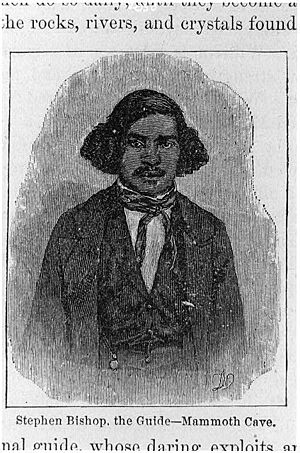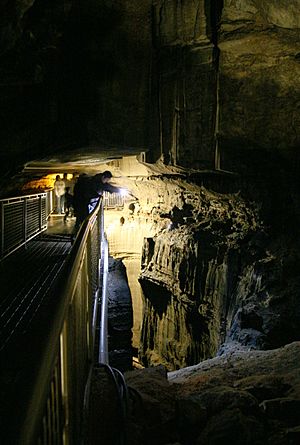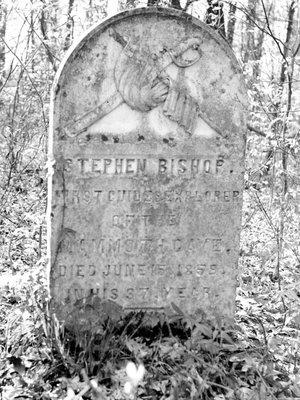Stephen Bishop (cave explorer) facts for kids
Quick facts for kids
Stephen Bishop
|
|
|---|---|
 |
|
| Born | c. 1821 |
| Died | 1857 (aged 35–36) |
Stephen Bishop (born around 1821, died 1857) was a mixed-race person who was enslaved. He became famous as a lead explorer and guide for the Mammoth Cave in Kentucky, USA. He was freed from slavery just one year before he died.
Stephen was introduced to Mammoth Cave in 1838. Franklin Gorin, the man who enslaved him, bought the cave that year. Gorin later wrote about Stephen, saying he was a "celebrated and great" guide. He also said Stephen helped make many discoveries. Stephen was the first person to cross the "Bottomless Pit." He, Gorin, and one other person were the only ones to reach the bottom of "Gorin's Dome."
After Stephen crossed the Bottomless Pit, they found many new parts of the cave. Before that, people only knew the "Old Cave." Stephen often described the new areas as "grand, gloomy, and peculiar." Gorin also noted that Stephen taught himself. He was very smart and funny. He knew a little Latin and Greek. He also understood a lot about geology and people.
Contents
Stephen Bishop's Cave Adventures
Stephen Bishop had a unique style when guiding tours. He wore a chocolate-colored slouch hat, a green jacket, and striped pants. In his free time, he explored and named large parts of the cave. He quickly doubled the known map of the cave in just one year.
He started the tradition of naming cave areas. He used a mix of American and classical names. Examples include the River Styx, the Snowball Room, and Gorin's Dome. He found strange creatures like blind fish, snakes, and silent crickets. He also found old remains of cave bears. He even discovered ancient gypsum workings left by Indigenous people.
A visitor named Willis once described Stephen as "very picturesque." He said Stephen looked like a Spaniard. He had black, curly hair and a long mustache. Stephen was of average height but looked like an athlete. He had a broad chest and shoulders. Willis noted that Stephen was used to meeting many different people.
Crossing the Bottomless Pit
After exploring all the known parts of Mammoth Cave, Stephen Bishop started to get bored. He felt sure there was more to discover. But other experienced guides would not go past a certain point. The farthest anyone had gone was to the "Bottomless Pit." This was a huge, dark hole. No one dared go near it, fearing they would be lost forever.
Stephen was very brave, and his curiosity was stronger than his fear. He went to the pit with a guest who was just as curious. They used a cedar sapling (a young tree) to lay across the wide opening of the pit. Slowly, they ventured across. What they found opened up a whole new part of the cave.
A short distance past the pit, Stephen discovered a river. This was the first body of water ever found in the cave. As he explored the river, he found fish with no eyes. No one had ever heard of such creatures before. This discovery brought scientists to the cave to study these new animals. Many of the most popular areas of the cave were discovered and named by Stephen after he crossed the Bottomless Pit.
Stephen Bishop's Amazing Map
In 1839, Dr. John Croghan bought the Mammoth Cave Estate. This included Stephen Bishop and other enslaved people. Dr. Croghan briefly ran a hospital inside the cave. He thought the cave air might cure tuberculosis, a serious illness. Sadly, tuberculosis later caused the deaths of both Stephen Bishop and Dr. Croghan.
In 1842, Stephen was sent to Dr. Croghan's home in Louisville. For two weeks, Stephen drew a map of the cave system from memory. This map was later published in 1844. It was unusual for an enslaved person to get full credit for their work, but Stephen did. His map was used for over 40 years!
Stephen's map showed about 16 kilometers (10 miles) of cave passages. He discovered half of these himself. Even though it wasn't a modern, exact map, he carefully showed how wide and long the passages were. He even used shading to show water, just like modern mapmakers do. The way the cave passages connected was very accurate. Stephen's map was the first to truly show how huge Mammoth Cave was. It also showed how connected all its parts were. Even after 160 years, Stephen's map still makes people interested in the cave and in him.
In 1972, modern explorers found a connection between the Flint Ridge Cave system and Mammoth Cave. They were amazed to see that Stephen's map had actually shown this connection! It was a long, thin line branching off from the Echo River area. A dam built in 1905 had flooded this passage, hiding it. Explorers rediscovered it from the other end. Stephen had unknowingly shown the key to connecting two major parts of the world's longest cave, 130 years before anyone else did.
Stephen Bishop's Family Life
While at Dr. Croghan's home, Stephen met Charlotte Brown. She was an enslaved house worker for the Croghan family. They got married around 1843. About a year later, in 1844, their son Thomas Bishop was born. We don't know much about Thomas. Stephen's nephew, Eddie, also became a guide at Mammoth Cave, following in his uncle's footsteps.
Freedom and Legacy
Stephen Bishop was freed in 1856. This happened seven years after Dr. Croghan died, as stated in Croghan's will. Stephen had talked about buying his wife and son's freedom. He also spoke of moving to Liberia, a country in Africa. However, he decided not to go. Soon after his family was freed, Stephen bought a small piece of land for them instead. Stephen Bishop died on June 15, 1857.
Stephen's wife, Charlotte Brown, later reunited with her brother, Jim Brown. She passed away in 1897. After Stephen's death, she married another cave guide named Nick Bransford.
Stephen Bishop was buried on a hill above the cave. This area became known as "The Old Guides' Cemetery." Years later, in 1878, a man named James Ross Mellon visited the cave. He heard many stories about Stephen. He also met Charlotte, who was managing the hotel dining room. She showed him Stephen's grave, which only had a cedar tree marking it. Mellon promised to get a headstone for Stephen's grave.
In 1881, a stonemason used an old tombstone that had not been paid for. He carved off the original name. Then he added a new message:
STEPHEN BISHOP, FIRST GUIDE & EXPLORER OF THE MAMMOTH CAVE. DIED JUNE 15, 1859 IN HIS 37 YEAR.
The stone was sent to the cave and placed on Stephen's grave. Even though the death date was wrong (1859 instead of 1857), it helped make Stephen's story even more famous.
Stephen Bishop in Books
- In 2009, author Roger W. Brucker wrote Grand, Gloomy, and Peculiar: Stephen Bishop at Mammoth Cave. This historical novel is told from the point of view of Stephen's wife, Charlotte Brown.
- In 2004, Elizabeth Mitchell wrote Journey to the Bottomless Pit: The Story of Stephen Bishop & Mammoth Cave. This historical novel is told from Stephen's point of view.
- Stephen Bishop is an important character in Alex Irvine's 2002 novel A Scattering of Jades.
See also
 In Spanish: Stephen Bishop para niños
In Spanish: Stephen Bishop para niños



